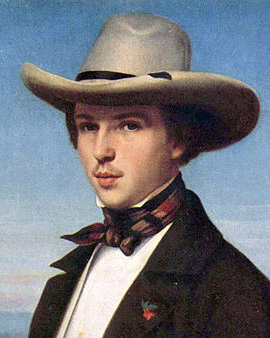A character who captured the colors of nature like no other, Oswald Achenbach made history as a remarkable landscape painter of the Düsseldorf School of Painting in the 19th century. He was not only an artist, but also a mentor and teacher, leading a master class at the Düsseldorf Art Academy in 1866/1867. Under his care, painters such as Gregor von Bochmann, Themistocles von Eckenbrecher and Louis Kolitz flourished. Achenbach's artistic career itself began early: at the age of 8 he was already accepted into the elementary class of the academy. During his early years he worked in the shadow of his older brother Andreas Achenbach, but nevertheless developed into an internationally sought-after artist.
Achenbach was known for his unconventionality and willingness to experiment. Instead of the usual brush, he liked to reach for the palette or even the finger to apply thick layers of paint. If he was dissatisfied with a painting, he simply painted a new motif over it. Achenbach's tireless desire to travel took him to the remotest corners, from which he brought back oil sketches and notes as souvenirs. He was particularly taken with the picturesque landscapes of Italy. As a conscientious observer, he devoted himself to the play of light, shadow and color and created in this way about 2000 masterpieces, which are now offered as art prints by us.
After he gave up his professorship in 1872, he devoted himself fully to his painting. Achenbach's travels took him back to Italy again and again, where he found his favorite motifs. The thick application of colors, which he further refined during this phase, lent his works almost relief-like qualities. He allowed the canvas to partially show through to incorporate the background, and it happened that several layers of his colors overlapped. Achenbach attached great importance to the overall effect of his paintings and played with contrasting accents. He increasingly turned to pastel tones, leaving behind the brownish hues of his early works. After one last look at his own favorite painting, "Pio Norno," he departed this life. Today, his artistic legacy lives on in the high-quality art prints of his works, which we reproduce with the greatest care and attention to detail.
×





.jpg)
.jpg)
.jpg)
.jpg)
.jpg)
.jpg)
.jpg)
.jpg)
.jpg)
.jpg)
.jpg)
.jpg)
.jpg)
.jpg)
.jpg)
.jpg)
.jpg)
.jpg)
.jpg)
.jpg)
.jpg)
.jpg)
.jpg)
.jpg)
.jpg)
.jpg)
.jpg)
.jpg)
_-_Peinture_de_Oswald_Achenbach_(1827-1905)_huil_-_(MeisterDrucke-1314107).jpg)
_-_Peinture_de_Oswald_Achenbach_(1827-1905)_huil_-_(MeisterDrucke-1314107).jpg)
.jpg)
.jpg)
.jpg)
.jpg)
.jpg)
.jpg)
.jpg)
.jpg)
.jpg)
.jpg)
.jpg)
.jpg)
.jpg)
.jpg)
_-_(MeisterDrucke-910447).jpg)
_-_(MeisterDrucke-910447).jpg)
.jpg)
.jpg)
.jpg)
.jpg)
.jpg)
.jpg)
.jpg)
.jpg)
.jpg)
.jpg)
.jpg)
.jpg)
.jpg)
.jpg)
.jpg)
.jpg)
.jpg)
.jpg)
.jpg)
.jpg)
.jpg)
.jpg)
.jpg)
.jpg)
.jpg)
.jpg)
.jpg)
.jpg)
.jpg)
.jpg)
.jpg)
.jpg)
.jpg)
.jpg)
_Peinture_dOswald_Achenbach_(1827-19_-_(MeisterDrucke-1317942).jpg)
_Peinture_dOswald_Achenbach_(1827-19_-_(MeisterDrucke-1317942).jpg)
.jpg)
.jpg)
.jpg)
.jpg)
.jpg)
.jpg)
.jpg)
.jpg)
.jpg)
.jpg)
.jpg)
.jpg)
.jpg)
.jpg)
.jpg)
.jpg)
.jpg)
.jpg)
.jpg)
.jpg)
.jpg)
.jpg)
.jpg)
.jpg)
.jpg)
.jpg)
.jpg)
.jpg)
.jpg)
.jpg)
_-_(MeisterDrucke-1172632).jpg)
_-_(MeisterDrucke-1172632).jpg)
.jpg)
.jpg)
.jpg)
.jpg)
.jpg)
.jpg)
.jpg)
.jpg)
.jpg)
.jpg)
.jpg)
.jpg)
.jpg)
.jpg)
_-_(MeisterDrucke-908382).jpg)
_-_(MeisterDrucke-908382).jpg)
.jpg)
.jpg)
.jpg)
.jpg)
.jpg)
.jpg)
_Promenade_dans_un_parc_Peinture_de_Oswald_Ac_-_(MeisterDrucke-1314271).jpg)
_Promenade_dans_un_parc_Peinture_de_Oswald_Ac_-_(MeisterDrucke-1314271).jpg)
.jpg)
.jpg)
.jpg)
.jpg)
.jpg)
.jpg)






